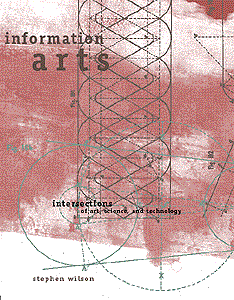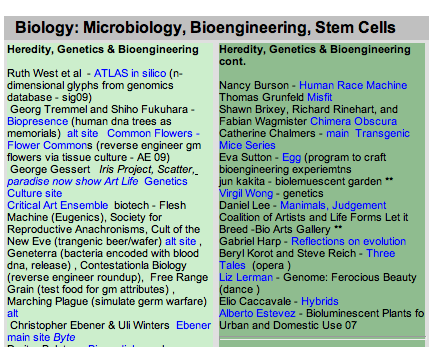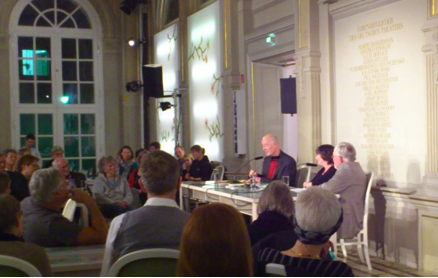
Stephen Wilson. Information arts. Intersections of Arts, Science and Technology. The MIT Press/Leonardo Books, 2002.

Stephen Wilson. Art + Science Now. Thames & Hudson, London, 2010.

Interdisciplinary research lines at Stephen Wilons' Website.

2012 SEAD White Paper Call for a better cooperation between science, technologie, art & design

"The art of living. A discussion with Hans Joachim Schellnhuber and Lars Gustafsson."
A cooperation between the project ÜBER LEBENSKUNST with the Berliner Künstlerprogramm of the DAAD and the Potsdam Institute for Climate Impact Research.
Deutsches Theater, Berlin, 20. November 2012. Foto: KlimaTeam of the BildungsCent e.V.
More here: Video |
A Research Agenda at the Crossroads between Art, Science, Technology and Society? From the interdisciplinary agenda pioneer Stephen Wilson to the SEAD White Papers.
Stella Veciana
The history of science describes how the scientific disciplines and their scientific objects have repeatedly gone through fundamental changes over the centuries. Lorraine Daston demonstrates in her book "A Brief History of scientific attention", how the epistemological interest of the 16th and 17th century in strange anomalies or deformed creatures, in the 18th century focused on everyday phenomena such as worms and insects. The early researchers who decided to explore such "inferior and banal" animals, however, were faced with vehement criticism. The research pioneers were even ridiculed when they insisted on their "absurd and false" scientific objects. Today, the discussion about whether research subjects are eligible or not does not concern insects or reptiles, but for example, sustainability research. How do new research topics get legitimated nowadays? To what extent is the attention of scientists currently directed by excellence and eligibility criteria? Does the Research Arts need their own research agenda or can their research lines be integrated into other areas? What kind of socially relevant knowledge could and should the Research Arts generate?
The first comprehensive summary of the lines of research coming together at the interface of art, science and technology, was developed by Stephen Wilson (* 1944, † 2011 San Francisco, USA) and published in his book "Information Arts" (2002). Wilson contextualizes the "Information Arts" within information society, and in relation to critical theory. He categorizes them according to the media materialism that developed out of the information aesthetics[1] tradition of the 70s. His classification in six research areas is therefore based primarily on the "information value" of the research as material / product, and on the medium of technical production. In the 2010 publication Art + Science Now, the six categories were extended to eight areas of research. Based on Wilson’s website, and with some references from his publication Information Arts, a list of the areas of priority would read as follows:
1. "Conceptual Kinetics, Electronics, Physical Computing; Robotics; Activated Objects, Mixed Reality, Tangible Interfaces, Virtual/Physical Connections; Kinetic Instruments, Sound Installation, Industrial". This research area corresponds to the research field of kinetics, robotics and audio installations, where the exploration of behaviour (mimetic, synthetic, or both) of robots, Mixed Realities and their interactions and industrial applications play a significant role. It is based on technologies such as microprocessors, electronic sensors or physical computing. From the very beginning, this field has found much appreciation in popular culture and has attracted many autodidacts. The debate about it’s social implications relies for instance on the relationship between man and machine, and on the hybridization of the body with prostheses.
2. "Motion, Gesture, Touch, Gaze, Manipulation, Haptics; Artificial Intelligence & Agents; Information Systems, Surveillance, Science as Information System, Shadow Corporations; Speech Synthesis, Voice Recognition, and 3-D Sound; Virtual Reality (immersive); Computer Media; Artist Games". In this research field Wilson gathers works that explore the perception of smell, taste and touch, as well as research dealing with artificial intelligence, control systems, autonomous agents, information systems, gesture and voice recognition, synthesized speech, virtual reality and games. The critical analysis includes the social implications of these technologies, such as surveillance with bio-marker identification, or the social effects associated with virtualization / dematerialization.
3. "Biology: Microbiology, Bioengineering, Stem Cells; Biology: Animals & Plants; Ecology; Body & Medicine". This research line includes research on the molecular and cellular level of organisms, stem cell research, bioengineering, biosensors and bionics. The technologies used are computer simulation, nanotechnology, cloning and the functional visualization of chemical processes. Other research subareas are dedicated to models of biological and economic phenomena / systems, such as the model of DNA, artificial life, experimental manipulation of behaviour, or the networks of nerve cells. Here the critical discussion is concerned with bioethics or in terms of biological warfare.
4. "Algorithms, Art & Mathematics, Code, Genetic Art, Artificial Life; Atomic Level Physics, Nanotechnology; Natural Phenomena - Non-linear Dynamic Systems, Water, Weather, Solar Energy, Geology, Mechanical Motion; Space Art; Rapid Prototyping Sculpture; Holography". This research field is dedicated in particular to mathematics and nanotechnology. Abstract structures and patterns are examined with technical means, ranging from topology, cryptography, X-Ray systems, holography, rapid prototyping to the research of nonlinear dynamic systems. Other areas include the study of water, weather, geology, or solar energy. Wilson criticized the lack of artistic interest in the art of "phenomena", which he explained with the trend set by Nicholas Negroponte, to "move bits, not atoms." Critical perspective of these 'designs of reality' that are considered are, for example, the visual representations of artificial life.
5. "Telecommunications, Wireless,Web Art, GPS (Global Positioning System) / Locative Media, Holography". This area is one of the most popular fields of research for artists, according to Wilson. With the development of new technologies and devices such as the telephone, the radio and the Internet, the possibilities and forms of communication have expanded more and more, overcoming both geographical distance and the formation of social networks. The technology ranges from tele- and videoconferencing, GPS applications, satellites, Internet collaborations over wireless network, voice recognition, security systems, communications, telepresence and telesensing. The critical implications of this field include the impact of telecommunications on identity and relationship-building, social exchange, social control and privacy.
The research areas Wilson has focused on are subject to the selection criteria of technological innovation. A similar research agenda has recently been taken up by the North American Network of SEAD, Network for Science, Engineering, Arts and Design. In its annual report of 2012, SEAD describes itself as a "community of scholars and research practices that bridges the gap between computer science, technology and creativity". Currently, a working group of SEAD is tendering and evaluating more than 70 white paper entries, leading to a comprehensive report to the U.S. National Science Foundation. This report will provide information on the needs, opportunities, barriers and improved possibilities of cooperation, for this research community of artists, scientists, engineers and designers. It will also contextualize the findings with those of other international reports, and ultimately serve to develop a common platform.
This approach allows all interested stakeholders to participate, and, at best, to develop a shared approach. The extent to which the participation of civil society is wished for, can only be seen in the finished report. The participation of the "experts of everyday life" and a focus on sustainability issues are, however, the priority areas of RESEARCH ARTS. References to social innovation beyond technology appears in Wilson, if at all, only partially in the critical component of the arts. The development of a Citizen Science or on a science based on sustainability does not seem to be an explicit part of the orientation of the SEAD. The so-called “Grand Challenges” of climate change, world nutrition and resource scarcity, are also concerns of the research community at the intersection of art, science, technology and society, and reorients them in these directions. One example of scientists and artists already debating current topics on sustainability, was the dialog between Hans Joachim Schellnhuber and Lars Gustafsson, held recently at the Deutsches Theater in Berlin.
The physicist Hans Joachim Schellnhuber[2] and the poet and philosopher Lars Gustafsson[3] addressed concerns relevant to sustainability, such as intergenerational democracy, the necessity of an ecological-cultural activity, and the search for possible alternatives for society and a "good life". Gustafsson started by sharing the metaphor of a person filling the bathtub in the morning to have a bath, having breakfast in the meantime and forgetting about the water running. Schellnhuber imagined an even more complicated picture of a whole bunch of baths, all of which will be overflowing at different points of time with a determinable probability if we do not change our behaviour. The extent of climate change would correspond to the accelerated pace of American roulette. Only one generation anyway still has the opportunity to counteract this environmental dilemma. One idea of the "good life" would be an attempt to break out of Reason "as an intellectual prison", replacing it with "thinking outside the box," said Gustafsson. Afterwards Schellnhuber argued, that the way to a "good life" could be achieved by using common sense rather than strategic plans, as experience has shown to him.
In short, this metaphorical conversation between the scientist and the artist was followed closely by a very interested audience. Unfortunately, this attention was not rewarded with a direct exchange, as there was no time for questions and answers. The communication of knowledge consequently remained one-sided and imprisoned in an ivory tower, instead of engaging in an open dialogue with the community. Nevertheless, this example and many other events indicate a growing number of actors interested in this research field. It is time to think about a possible research agenda for the RESEARCH ARTS on an European scale.
↑ 1. The aesthetics of information is characterized by autonomy of form and a method that is based on concepts and logical rules. Gianetti distinguishes between computer art (Frieder Nake, Georg Nees, Kurd Ausleben, Barbadillo, Eusebio Tempere, among others), rational aesthetics (George David Birkhoff), informational aesthetics (Max Bense, Andre Abraham Moles), cybernetics (Herbert W . Franke, Siegfried Maser, Helmer. Frank), generative and participatory aesthetics (Frieder Nake, Georg Nees, Kurd Alsleben) and the aesthetics of perception (Herbert W. Franke, Frank Helmer).
↑ 2. Hans Joachim Schellnhuber, Professor of Physics, Director of the Potsdam Institute for Climate Impact Research PIK and Chairman of the Scientific Advisory Council on Global Change.
↑ 3. Lars Gustafsson. Poet and philosopher, published 2011 "Gegen Null. Eine mathematische Phantasie" in the Secession Publisher and is "Artist in Residence" at the Potsdam Institute for Climate Impact Research PIK.
comment |